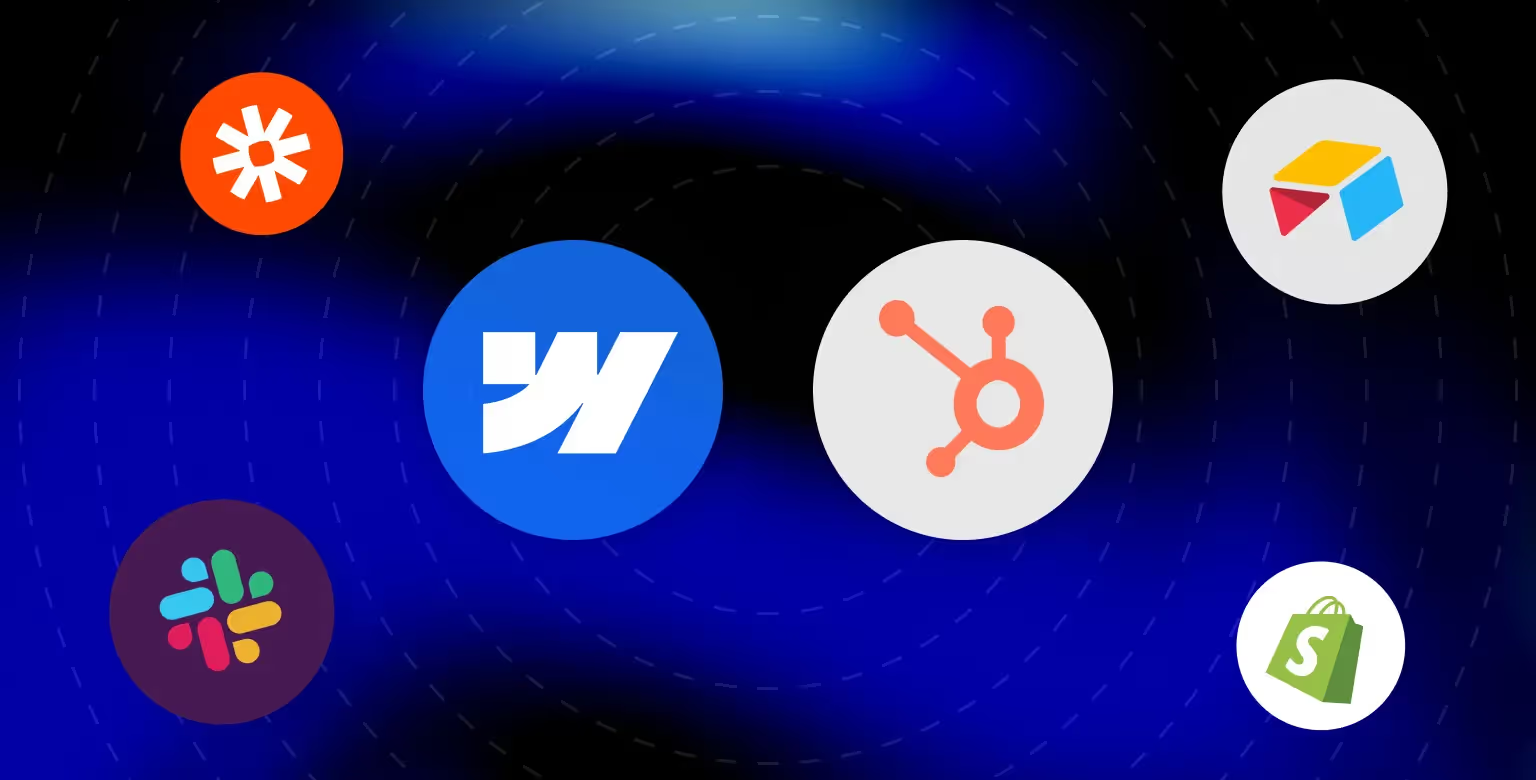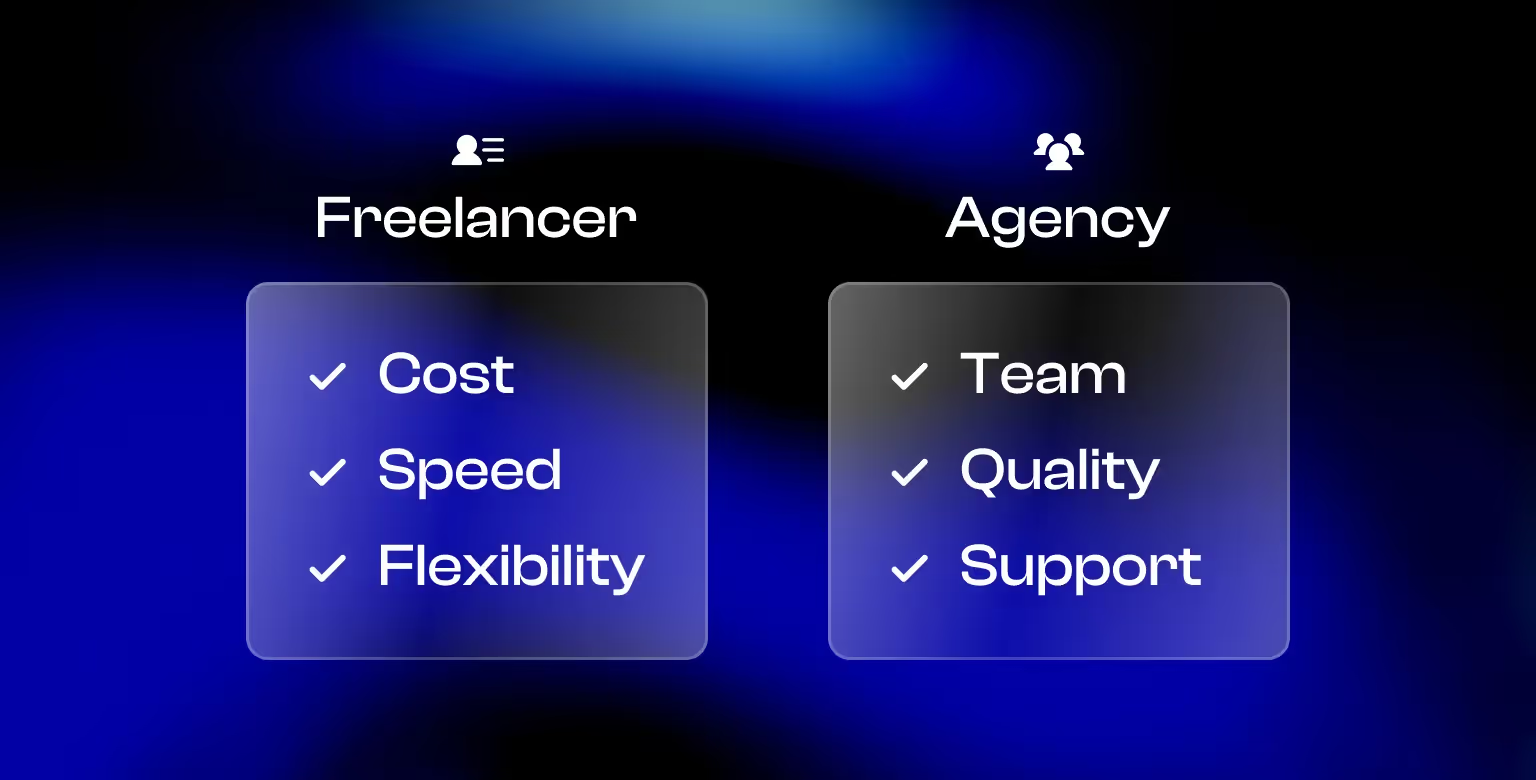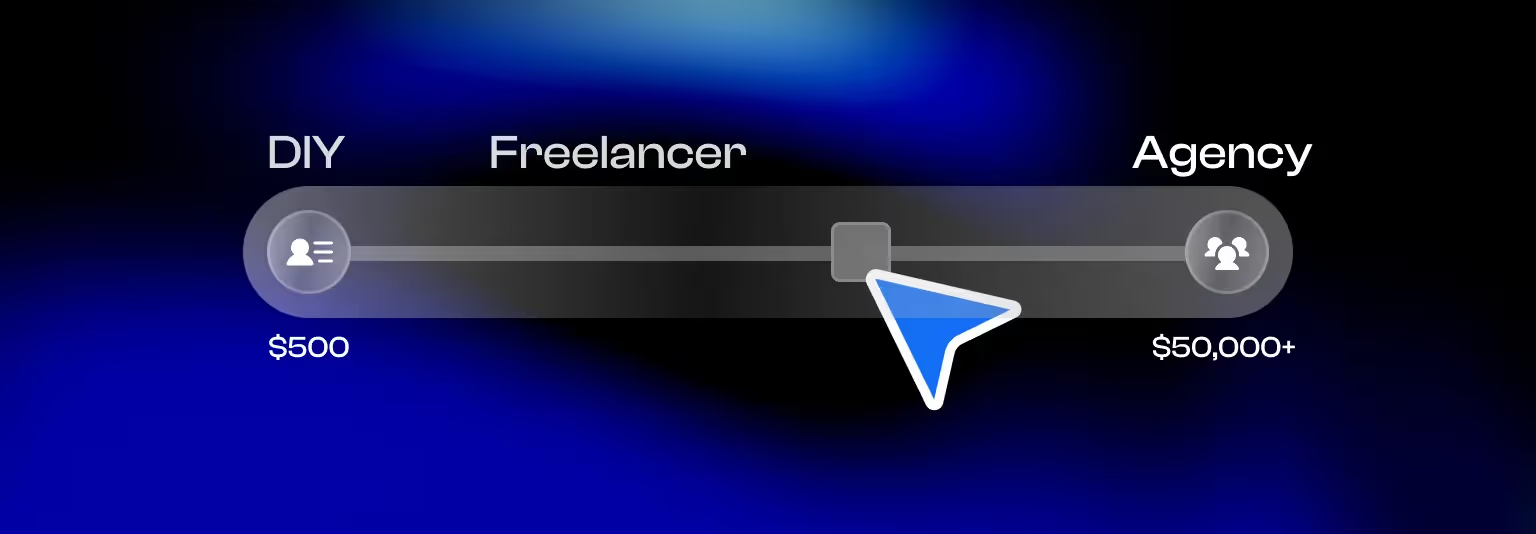There’s no single way to build a Webflow website—and no single price tag either.
In this guide, we break down the three main paths for building a Webflow website:
- Doing it yourself (DIY)
- Hiring a freelancer
- Partnering with a Webflow agency
We’ll look at the real costs involved—both visible and hidden—and help you understand how scope, complexity, and business priorities shape the investment.
This article is for startup founders, marketers, and decision-makers evaluating how to best build their site with Webflow—and whether the cheapest option really delivers the best value.
Note: If you're still evaluating Webflow as a platform, start with our Ultimate Guide to Webflow Pricing to understand Site Plans, Workspace Plans, and platform-level costs.
Let’s start with the baseline expenses that apply to all Webflow builds, regardless of how you execute them.
Webflow’s Platform Costs and Basic Expenses
Before comparing execution methods, it’s important to understand the baseline expenses of using Webflow. These costs apply regardless of whether you build the site yourself or hire professionals.

Site Plans
Webflow requires a Site Plan for any project hosted on a custom domain. There are several tiers:
Ecommerce plans start at $29/month and go up to $212/month depending on volume and product needs.
Domain Registration
A custom domain is purchased separately from platforms like Google Domains or Namecheap. Standard domains cost around $10–$20 per year, while premium domains can reach up to a million dollars.
Templates (Optional)
Webflow offers both free and paid templates. Premium templates range from $50 to $150. These can reduce design time but may limit uniqueness.
Add-ons and Integrations
Depending on your needs, you might need third-party tools:
- Email marketing (e.g. Mailchimp, Klaviyo)
- Membership tools (e.g. Memberstack, Outseta)
- Automation tools (e.g. Zapier, Make)
Expect to pay anywhere from $10 to $100/month depending on stack complexity.
Summary
Even with a DIY build, your baseline expenses include:
- Webflow Site Plan ($14–$39/month or more)
- Domain (~$10–$20/year)
- Optional template or integrations ($50–$100+ one-time or monthly)
These platform costs are the foundation—actual build costs vary widely based on how you execute the project.
Key Factors Influencing Webflow Website Cost
The cost of building a Webflow website isn’t determined by platform fees alone. It depends heavily on the scope of your site and how it’s executed.
1. Design Complexity
Design plays a central role in pricing. The more bespoke and interactive your design, the more time it takes to implement.
- Custom designs take longer than template-based builds
- Complex animations or visual effects (e.g. Lottie, GSAP) increase dev time
- Sites with detailed branding often require more rounds of design feedback
Need expert help translating branding into design? Our B2B web design agency specializes in that.
2. Number of Pages
Page volume directly impacts development hours and overall cost.
- A single landing page costs far less than a multi-page site
- CMS collections (for blogs, case studies, etc.) add development time
- Larger sites require more testing and QA, which increases hours billed
3. E-commerce or Advanced Functionality
Sites with additional functionality require more setup, testing, and sometimes external tools.
- Online stores need product databases, cart systems, and checkout integrations such as Stripe
- Memberships, gated content, or multilingual support require additional tools and setup
- These features significantly increase development time and sometimes require custom code or external platforms
4. Content Production
Not every client provides ready-to-go content—and creating high-quality content is labor intensive.
- Sites without pre-written content will need copywriting services
- Agencies may also offer brand voice alignment, tone guides, and page structuring
- Good copy improves performance but adds cost upfront
Not sure where to start with structuring your content? Read our guide on how to build a business website.
5. Performance and SEO Optimization
Performance and discoverability aren’t automatic—they require time and attention.
- Image compression, lazy loading, and page speed tuning are not always included by default
- On-page SEO setup (meta tags, alt tags, canonical links) may come standard, but deep optimization is often extra
- Schema markup, internal linking, and advanced SEO are usually scoped separately
If technical SEO is a priority for your site, you may want to consult an SEO agency for tech startups.
6. Timeline and Revisions
How fast you need the site—and how flexible you are—can impact cost.
- Tight deadlines usually come with rush fees or compressed schedules (which increases risk and cost)
- Projects with unclear scopes or unlimited revisions can balloon in cost
7. Third-Party Tools and Integration
Integrating with external systems increases development time and sometimes adds licensing fees.
- CRMs, analytics, payment systems, and marketing stacks all add integration time
- Some tools also introduce licensing costs billed separately (e.g. HubSpot, Typeform, Memberstack)

Summary Table: Feature Impact on Cost
These variables shape the real cost of building a Webflow website. The more complex the need, the more value there is in working with experienced Webflow development agency that can build it right the first time.
Once your scope is defined, use our Website Launch Checklist to make sure nothing gets missed.
DIY Webflow Website: Costs and Hidden Challenges
Building a Webflow site yourself may seem like the most cost-effective option, but the savings come with trade-offs.
Out-of-Pocket Costs Are Minimal
Your expenses are limited to essential platform costs, unless you add templates or third-party tools.
- Monthly Webflow Site Plan: $14–$39 (or higher for e-commerce)
- Domain name: ~$10–$20/year
- Optional: Paid template ($50–$150) or third-party tools (~$10–$100/month)
- Total cash cost: Often under $500/year if kept simple
Your Time Is the Real Investment
DIY comes with a steep learning curve—even for tech-savvy marketers.
- Learning curve: Even with Webflow University, it takes time to master layout, responsiveness, CMS, interactions
- Expect to spend 40–100+ hours for a decent result, especially without prior experience
- For founders or marketers, this is time not spent on core business activities
Quality Risks and Tech Debt
Without best practices, you risk technical issues that require expensive fixes later.
- Common pitfalls include poor mobile responsiveness, inconsistent class usage, and SEO oversights
- Without best practices, performance suffers (slow loads, bloated layouts, accessibility issues)
- Sloppy builds often need to be rebuilt later — creating hidden future costs
Missed Strategic Value
The site may “look fine” but underperform in metrics that matter—especially without input from conversion rate optimization experts who understand how to design for results, not just appearance.
- DIY builders often focus on aesthetics rather than conversions or user flows
- No CRO, A/B testing, or structure to support scaling content
- The site may “look fine” but underperform in metrics that matter
If your project supports a high-stakes offer or complex buyer journey, we recommend starting with a clear B2B website strategy to align messaging, design, and conversion goals from day one.
When DIY Might Make Sense
There are a few scenarios where DIY is appropriate—if expectations are realistic.
- Personal projects, MVPs, or temporary sites where budget is extremely limited
- Founders with time and a desire to learn Webflow
- Use case must tolerate imperfections or plan for a future professional rebuild
Summary
DIY saves money but shifts the cost to your own time and the potential for rework. It’s viable for early-stage, non-critical use cases, but not recommended for growth-stage or revenue-driving websites.
Hiring a Freelance Webflow Developer: Pros, Cons, and Costs
Freelancers strike a middle ground between DIY and agency pricing. They’re often the first step for growing businesses with limited budgets but higher expectations.
Typical Pricing Ranges
Freelance pricing can vary significantly based on the developer’s experience and the complexity of your project.
- Hourly rates: $30–$100+, depending on location and experience
- Flat project rates: $2,000–$10,000 for small to mid-sized business sites
- Complex or high-touch projects may exceed $10k, especially with animations or integrations
Why Freelancers Cost Less Than Agencies
Freelancers operate lean, which makes their services more affordable compared to full-service agencies.
- Lower overhead: No full-time staff, office space, or layers of management
- Lean operation: Often solo or part of a small collective
- Flexible pricing: Willing to adapt scope to match budgets
Strengths of Working with a Freelancer
They can bring speed, flexibility, and deep Webflow expertise to smaller-scale projects.
- Direct communication with the person doing the work
- Faster iterations and fewer bottlenecks
- High specialization in Webflow itself (some are former designers, others are developers)
Limitations and Risks
The trade-off is a lack of built-in support systems and backup resources.
- Limited capacity: One person can only do so much at once
- No built-in project manager, QA, or strategist — oversight is on you
- May lack complementary services like SEO, CRO, copywriting, or brand strategy
- Risk of delays if the freelancer takes on too much or becomes unavailable
Scope Matters
Freelancers are best suited for projects with clear boundaries and manageable complexity. They work best for:
- 1–10 page marketing sites
- Startups with pre-existing content and branding
- Projects that don’t require a full strategic process
They’re less ideal for:
- Enterprise-level websites
- Sites needing deep integrations, team collaboration, or ongoing support
Summary
Freelancers offer cost-efficiency and high quality for focused projects. But the narrower the freelancer’s skill set, the more responsibility falls on the client to manage, coordinate, and fill in gaps.

Working with a Webflow Agency: Costs, Pricing Models, and Value
Hiring a Webflow agency is the most expensive path, but it comes with strategic advantages and reduced execution risk. To learn more about the strategic benefits an agency brings (beyond just the price tag), read Why hire a Webflow agency?
Typical Pricing Ranges
Agency pricing reflects both the complexity of the build and the depth of service involved.
- Small business website: $5,000–$15,000
- Growth-stage or mid-market project: $15,000–$30,000
- Enterprise or high-complexity sites: $30,000–$100,000+
What You’re Paying For
Agencies offer more than just development—they bring a full team and structured process to your project.
- Multidisciplinary team: Designers, developers, project managers, SEO/CRO specialists
- Process-driven execution: Discovery, wireframing, prototyping, QA, post-launch support
- Accountability and structure: Clear scopes, deliverables, and project timelines
Common Agency Pricing Models
Agencies use different pricing structures depending on project scope, support level, and duration.
Pros of Hiring an Agency
An agency brings stability, structure, and scalability to high-stakes projects.
- Full-service approach with built-in strategic guidance
- Higher reliability for meeting deadlines and deliverables
- More robust QA and testing processes
- Better suited for long-term support or future scalability
When Agencies Make Sense
Agencies are the right fit when the website is central to your business or brand.
- Website is business-critical (e.g. product marketing, enterprise credibility)
- You need design, development, strategy, and optimization under one roof
- You want the project managed, not just built
Potential Trade-Offs
The downsides are primarily financial and logistical.
- Higher upfront cost
- Longer lead times before kickoff due to demand and process
- Less flexibility in scope once contracts are signed
Summary
Agencies are best for companies that need a fully managed, high-performance website. The price is significantly higher, but the outcome is more reliable — especially when stakes are high and timelines are tight.
DIY vs Freelancer vs Agency: Comparing Options and Making Your Decision
Choosing how to build your Webflow site isn’t just about cost—it’s about return on investment, time, and long-term maintainability. For a deeper comparison of freelancers vs agencies beyond just cost, read our article comparing Webflow Agency vs Freelancer.

Cost Comparison at a Glance
Each approach comes with its own pricing dynamics and typical cost range.
Timeline Considerations
Project duration varies by complexity and who’s executing it.
- DIY: Most flexible but longest to complete (weeks to months depending on your availability and learning curve)
- Freelancer: Projects usually take 2–6 weeks depending on scope
- Agency: 4–12+ weeks with defined phases and quality control
Quality and ROI Factors
The more experienced the team, the more likely your site performs well from launch.
- DIY: Limited to your skills. May require rebuilds. Risk of poor performance.
- Freelancer: Good value for small- to mid-sized projects if well-managed.
- Agency: Highest polish and structure. Better suited for CRO, SEO, and scaling content over time.
Maintenance and Long-Term Support
Who handles ongoing support, changes, and scaling?
- DIY: You own everything but must manage it yourself
- Freelancer: Support depends on availability and agreement
- Agency: Offers structured retainers and scalable support plans
Strategic Trade-offs
Beyond cost, consider future-proofing, business goals, and efficiency.
- Startups may begin with DIY or freelancers, then invest in an agency for redesign or scaling
- Rushed DIY builds often become sunk costs if they require rework
- Agencies are often the most efficient long-term solution for business-critical sites
Decision Guide
Use these questions to narrow down your path forward:
- Is this site going to drive leads, sales, or investor confidence?
- Do I have time and skills to manage it myself?
- Do I want a partner who can advise beyond just execution?
Your answers will make the best path clear. For a detailed breakdown of our deliverables, timelines, and investment ranges, see our Webflow agency pricing page to understand exactly what’s included at each level.
Frequently Asked Questions About the Cost of Building a Webflow Website
What is the average cost to build a Webflow website?
It depends on scope and who builds it. A DIY build might cost under $500/year. Freelancer-built sites range from $2,000 to $10,000. Agency projects start around $5,000 and can exceed $50,000 for complex or enterprise-level builds.
Is Webflow cheaper than WordPress?
Webflow has higher hosting costs but includes visual development, a built-in CMS, and no plugin maintenance. WordPress is cheaper upfront but may require ongoing developer help and plugin costs. Webflow can be more cost-efficient over time, especially for marketing teams. Read our article comparing Webflow to WordPress for a full breakdown of how they fare against each other beyond just cost
How much does a Webflow freelancer charge?
Hourly rates typically range from $30–$100+. Flat project rates vary based on complexity but most business websites fall between $3,000 and $8,000. The final price depends on number of pages, design needs, and integrations.
Can I build a Webflow website for free?
Yes, Webflow offers a free Starter plan, but you won’t be able to use a custom domain or remove Webflow branding. A professional site requires at least a Basic Site Plan ($14/month billed annually) and a domain.
If you’re going the DIY route, check out our Webflow development guides where we’ve written step-by-step tutorials for everything from setting up pages to customizing scroll animations.
What are the ongoing costs after launch?
You’ll need to maintain a Webflow hosting plan and domain. Optional costs may include:
- Third-party tools (analytics, forms, automation)
- Maintenance support (freelancer or agency retainer)
- New feature development or optimization
Is it better to hire an agency or a freelancer?
Freelancers are ideal for smaller projects with clear scopes. Agencies are better suited for complex, strategic builds requiring multiple skill sets and long-term support. If the site is tied to revenue or brand credibility, an agency is often worth the investment.





